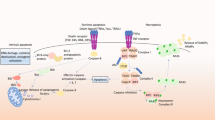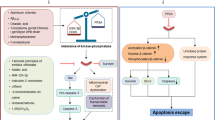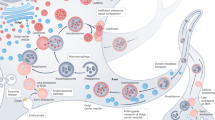Abstract
Neuronal apoptosis sculpts the developing brain and has a potentially important role in neurodegenerative diseases. The principal molecular components of the apoptosis programme in neurons include Apaf-1 (apoptotic protease-activating factor 1) and proteins of the Bcl-2 and caspase families. Neurotrophins regulate neuronal apoptosis through the action of critical protein kinase cascades, such as the phosphoinositide 3-kinase/Akt and mitogen-activated protein kinase pathways. Similar cell-death-signalling pathways might be activated in neurodegenerative diseases by abnormal protein structures, such as amyloid fibrils in Alzheimer's disease. Elucidation of the cell death machinery in neurons promises to provide multiple points of therapeutic intervention in neurodegenerative diseases.
This is a preview of subscription content, access via your institution
Access options
Subscribe to this journal
Receive 51 print issues and online access
$199.00 per year
only $3.90 per issue
Buy this article
- Purchase on SpringerLink
- Instant access to full article PDF
Prices may be subject to local taxes which are calculated during checkout





Similar content being viewed by others
References
Hamburger, V. & Levi-Montalcini, R. J. Exp. Zool. 111, 457–502 (1949).
Purves, D. Body and Brain: A Trophic Theory of Neural Connections (Harvard Press, Cambridge, Massachusetts, 1988).
Martin, D. P. et al. Inhibitors of protein synthesis and RNA synthesis prevent neuronal death caused by nerve growth factor deprivation. J. Cell Biol. 106, 829–844 ( 1988).
Metzstein, M. M., Stanfield, G. M. & Horvitz, H. R. Genetics of programmed cell death in C. elegans : past, present and future. Trends Genet. 14, 410–416 (1998).
Gagliardini, V. et al. Prevention of vertebrate neuronal death by the crmA gene. Science 263, 826– 828 (1994).
Merry, D. E. & Korsmeyer, S. J. Bcl-2 gene family in the nervous system. Annu. Rev. Neurosci. 20, 245– 267 (1997).
Garcia, I., Martinou, I., Tsujimoto, Y. & Martinou, J. C. Prevention of programmed cell death of sympathetic neurons by the bcl-2 proto-oncogene. Science 258, 302– 304 (1992).
Martinou, J. C. et al. Overexpression of BCL-2 in transgenic mice protects neurons from naturally occurring cell death and experimental ischemia. Neuron 13, 1017–1030 ( 1994).
Dubois-Dauphin, M., Frankowski, H., Tsujimoto, Y., Huarte, J. & Martinou, J. C. Neonatal motoneurons overexpressing the bcl-2 protooncogene in transgenic mice are protected from axotomy-induced cell death. Proc. Natl Acad. Sci. USA 91, 3309–3313 (1994).
Sagot, Y. et al. Bcl-2 overexpression prevents motoneuron cell body loss but not axonal degeneration in a mouse model of a neurodegenerative disease. J. Neurosci. 15, 7727–7733 (1995).
Veis, D. J., Sorenson, C. M., Shutter, J. R. & Korsmeyer, S. J. Bcl-2-deficient mice demonstrate fulminant lymphoid apoptosis, polycystic kidneys, and hypopigmented hair. Cell 75, 229–240 (1993).
Michaelidis, T. M. et al. Inactivation of bcl-2 results in progressive degeneration of motoneurons, sympathetic and sensory neurons during early postnatal development . Neuron 17, 75–89 (1996).
Gonzalez-Garcia, M. et al. bcl-x is expressed in embryonic and postnatal neural tissues and functions to prevent neuronal cell death. Proc. Natl Acad. Sci. USA 92, 4304–4308 (1995).
Motoyama, N. et al. Massive cell death of immature hematopoietic cells and neurons in Bcl-x-deficient mice. Science 267, 1506 –1510 (1995).
Deckwerth, T. L. et al. BAX is required for neuronal death after trophic factor deprivation and during development. Neuron 17, 401– 411 (1996).
Zou, H., Henzel, W. J., Liu, X., Lutschg, A. & Wang, X. Apaf-1, a human protein homologous to C. elegans CED-4, participates in cytochrome c-dependent activation of caspase-3 . Cell 90, 405–413 (1997).
Cecconi, F., Alvarez-Bolado, G., Meyer, B. I., Roth, K. A. & Gruss, P. Apaf1 (CED-4 homolog) regulates programmed cell death in mammalian development. Cell 94, 727–737 (1998).
Cryns, V. & Yuan, J. Proteases to die for. Genes Dev. 12, 1551–1570 ( 1998).
Li, P. et al. Cytochrome c and dATP-dependent formation of Apaf-1/caspase-9 complex initiates an apoptotic protease cascade. Cell 91, 479–489 (1997).
Kang, S. J. et al. Dual role of caspase-11 in mediating activation of caspase-1 and caspase-3 under pathological conditions. J. Cell Biol. 149, 613–622 (2000).
Nakagawa, T. et al. Caspase-12 mediates endoplasmic-reticulum-specific apoptosis and cytotoxicity by amyloid-β. Nature 403, 98–103 (2000).
Kuida, K. et al. Decreased apoptosis in the brain and premature lethality in CPP32-deficient mice. Nature 384, 368–372 (1996).
Kuida, K. et al. Reduced apoptosis and cytochrome c-mediated caspase activation in mice lacking caspase 9. Cell 94, 325– 337 (1998).
Barbacid, M. Structural and functional properties of the TRK family of neurotrophin receptors . Ann. NY Acad. Sci. 766, 442– 458 (1995).
Fruman, D. A., Meyers, R. E. & Cantley, L. C. Phosphoinositide kinases. Annu. Rev. Biochem. 67, 481–507 ( 1998).
Yao, R. & Cooper, G. M. Regulation of the Ras signaling pathway by GTPase-activating protein in PC12 cells. Oncogene 11, 1607–1614 (1995).
Philpott, K. L., McCarthy, M. J., Klippel, A. & Rubin, L. L. Activated phosphatidylinositol 3-kinase and Akt kinase promote survival of superior cervical neurons. J. Cell Biol. 139, 809–815 (1997).
Datta, S. R., Brunet, A. & Greenberg, M. E. Cellular survival: a play in three Akts. Genes Dev. 13, 2905–2927 (1999).
Yang, E. et al. Bad, a heterodimeric partner for Bcl-XL and Bcl-2, displaces Bax and promotes cell death. Cell 80, 285 –291 (1995).
Datta, S. R. et al. Akt phosphorylation of BAD couples survival signals to the cell-intrinsic death machinery. Cell 91, 231–241 (1997).
Brunet, A. et al. Akt promotes cell survival by phosphorylating and inhibiting a Forkhead transcription factor. Cell 96, 857–868 (1999).
Du, K. & Montminy, M. CREB is a regulatory target for the protein kinase Akt/PKB. J. Biol. Chem. 273, 32377–32379 (1998).
Riccio, A., Ahn, S., Davenport, C. M., Blendy, J. A. & Ginty, D. D. Mediation by a CREB family transcription factor of NGF-dependent survival of sympathetic neurons. Science 286, 2358–2361 ( 1999).
Kane, L. P., Shapiro, V. S., Stokoe, D. & Weiss, A. Induction of NF-κB by the Akt/PKB kinase. Curr. Biol. 9, 601–604 (1999).
Bonni, A. et al. Cell survival promoted by the Ras-MAPK signaling pathway by transcription-dependent and-independent mechanisms. Science 286, 1358–1362 (1999).
Koike, T., Martin, D. P. & Johnson, E. M. Jr Role of Ca2+ channels in the ability of membrane depolarization to prevent neuronal death induced by trophic-factor deprivation: evidence that levels of internal Ca2+ determine nerve growth factor dependence of sympathetic ganglion cells. Proc. Natl Acad. Sci. USA 86, 6421 –6425 (1989).
Mao, Z., Bonni, A., Xia, F., Nadal-Vicens, M. & Greenberg, M. E. Neuronal activity-dependent cell survival mediated by transcription factor MEF2. Science 286, 785–790 (1999).
Vaillant, A. R. et al. Depolarization and neurotrophins converge on the phosphatidylinositol 3-kinase-Akt pathway to synergistically regulate neuronal survival. J. Cell Biol. 146, 955–966 (1999).
Xia, Z., Dickens, M., Raingeaud, J., Davis, R. J. & Greenberg, M. E. Opposing effects of ERK and JNK-p38 MAP kinases on apoptosis. Science 270, 1326–1331 (1995).
Estus, S. et al. Altered gene expression in neurons during programmed cell death: identification of c-jun as necessary for neuronal apoptosis. J. Cell Biol. 127, 1717–1727 (1994).
Ham, J. et al. A c-Jun dominant negative mutant protects sympathetic neurons against programmed cell death. Neuron 14, 927– 939 (1995).
Imaizumi, K. et al. The cell death-promoting gene DP5, which interacts with the BCL2 family, is induced during neuronal apoptosis following exposure to amyloid beta protein. J. Biol. Chem. 274, 7975– 7981 (1999).
Putcha, G. V., Deshmukh, M. & Johnson, E. M. Jr BAX translocation is a critical event in neuronal apoptosis: regulation by neuroprotectants, BCL-2, and caspases . J. Neurosci. 19, 7476– 7485 (1999).
Deshmukh, M. & Johnson, E. M. Jr Evidence of a novel event during neuronal death: development of competence-to-die in response to cytoplasmic cytochrome c. Neuron 21, 695–705 (1998).
Dechant, G. & Barde, Y. A. Signalling through the neurotrophin receptor p75NTR. Curr. Opin. Neurobiol. 7, 413–418 (1997).
Frade, J. M., Rodriguez-Tebar, A. & Barde, Y. A. Induction of cell death by endogenous nerve growth factor through its p75 receptor. Nature 383, 166–168 (1996).
Casaccia-Bonnefil, P., Carter, B. D., Dobrowsky, R. T. & Chao, M. V. Death of oligodendrocytes mediated by the interaction of nerve growth factor with its receptor p75. Nature 383, 716– 719 (1996).
Bamji, S. X. et al. The p75 neurotrophin receptor mediates neuronal apoptosis and is essential for naturally occurring sympathetic neuron death. J. Cell Biol. 140, 911–923 (1998).
Davey, F. & Davies, A. M. TrkB signalling inhibits p75-mediated apoptosis induced by nerve growth factor in embryonic proprioceptive neurons . Curr. Biol. 8, 915–918 (1998).
Li, Y., Chopp, M., Jiang, N., Zhang, Z. G. & Zaloga, C. Induction of DNA fragmentation after 10 to 120 minutes of focal cerebral ischemia in rats. Stroke 26, 1252–1257; discussion 1257–1258 (1995).
Charriaut-Marlangue, C. et al. Apoptosis and necrosis after reversible focal ischemia: an in situ DNA fragmentation analysis. J. Cereb. Blood Flow Metab. 16, 186–194 ( 1996).
Namura, S. et al. Activation and cleavage of caspase-3 in apoptosis induced by experimental cerebral ischemia. J. Neurosci. 18, 3659–3668 (1998).
Martin, L. J. et al. Neurodegeneration in excitotoxicity, global cerebral ischemia, and target deprivation: a perspective on the contributions of apoptosis and necrosis. Brain Res. Bull. 46, 281– 309 (1998).
Su, J. H., Anderson, A. J., Cummings, B. J. & Cotman, C. W. Immunohistochemcial evidence for apoptosis in Alzheimer's disease. Neuroreport 5, 2529–2533 (1994).
Troncoso, J. C., Sukhov, R. R., Kawas, C. H. & Koliatsos, V. E. In situ labeling of dying cortical neurons in normal aging and in Alzheimer's disease: correlations with senile plaques and disease progression. J. Neuropathol. Exp. Med. 55, 1134– 1142 (1996).
Selkoe, D. J. Alzheimer's disease: genotypes, phenotypes and treatments. Science 275, 630–631 ( 1997).
Yankner, B. A. Mechanisms of neuronal degeneration in Alzheimer's disease. Neuron 16, 921–932 ( 1996).
Geula, G. et al. Aging renders the brain vulnerable to amyloid β-protein neurotoxicity. Nature Med. 4, 827– 831 (1998).
Behl, C., Davis, J. B., Lesley, R. & Schubert, D. Hydrogen peroxide mediates amyloid β protein toxicity. Cell 77, 817–827 (1994).
Mattson, M. P., Tomaselli, K. J. & Rydel, R. E. Calcium-destablizing and neurodegenerative effect of aggregate beta-amyloid peptide are attenuated by basic FGF. Brain Res. 621, 35–49 ( 1993).
Loo, D. T. et al. Apoptosis is induced by β-amyloid in cultured central nervous system neurons. Proc. Natl Acad. Sci. USA 90 , 7951–7955 (1993).
Yan, S. D. et al. RAGE and amyloid-β peptide neurotoxicity in Alzheimer's disease. Nature 382, 685– 691 (1996).
Yaar, M. et al. Binding of beta-amyloid to the p75 neurotrophin receptor induces apoptosis. A possible mechanism for Alzheimer's disease. J. Clin. Invest. 100, 2333–2340 (1997).
Lorenzo, A. et al. Amyloid-β interacts with the amyloid precursor protein: a potential toxic mechansim in Alzheimer's disease. Nature Neurosci. 3, 460–464 ( 2000).
Estus, S. et al. Aggegated amyloid-beta protein induces cortical neuronal apoptosis and concomitant 'apoptotic' pattern of gene induction. J. Neurosci. 17, 7736–7745 ( 1997).
Troy, C. M. et al. Caspase-2 mediates neuronal cell death induced by beta-amyloid . J. Neurosci. 20, 1386– 1392 (2000).
Sherrington, R. et al. Cloning of a gene bearing missense mutations in early-onset familial Alzheimer's disease. Nature 375, 754–760 (1995).
Levy-Lahad, E. et al. Candidate gene for chromosome 1 familial Alzheimer's disease locus. Science 269, 973– 977 (1995).
Price, D. L., Tanzi, R. E., Borchelt, D. R. & Sisodia, S. S. Alzheimer's disease: genetic studies and transgenic models. Annu. Rev. Genet. 32, 461–493 (1998).
Scheuner, D. et al. Secreted amyloid β-protein similar to that in the senile plaques of Alzheimer's disease is increased in vivo by the presenilin 1 and 2 and APP mutations linked to familial Alzheimer's disease. Nature Med. 2, 864–870 ( 1996).
Wolfe, M. S. et al. Two transmembrane aspartates in presenilin-1 required for presenilin endoproteolysis and γ-secretase activity. Nature 398, 513–517 ( 1999).
Li, Y. M. et al. Photoactivated γ-secretase inhibitors directed to the active site covalently label presenilin 1. Nature 405, 689–694 (2000).
Mattson, M. P., Guo, Q., Furukawa, K. & Pedersen, W. A. Presenilins, the endoplasmic reticulum, and neuronal apoptosis in Alzheimer's disease . J. Neurochem. 70, 1–14 (1998).
Giulian, D. et al. Specific domains of beta-amyloid from Alzheimer plaque elicit neuron killing in human microglia. J. Neurosci. 16, 6021–6037 (1996).
Tan, J. et al. Microglial activation resulting from CD40–CD40L interaction after beta-amyloid stimulation. Science 286, 2352–2355 (1999).
Brown, D. R., Schmidt, B. & Kretzschmer, H. A role of microglia and host prion protein in neurotoxicity of prion protein fragment. Nature 380, 345 –347 (1996).
Gonzalez-Scarano, F. B. Microglia as mediators of inflammatory and degenerative diseases. Annu. Rev. Neurosci. 22, 219–240 (1999).
Ohagen, A. et al. Apoptosis induced by infection of primary brain cultures with diverse human immunodeficiency virus type 1 isolates: evidence for a role of the envelope. J. Virol. 73, 897– 906 (1999).
Scherzinger, E. et al. Huntingtin-encoded polyglutamine expansions form amyloid-like protein aggregates in vitro and in vivo. Cell 90, 549–558 (1997).
Lunkes, A. M. Polyglutamines, nuclear inclusions and neurodegeneration. Nature Med. 3, 1201–1202 ( 1997).
DiFiglia, M. et al. Aggregation of huntington in neuronal intranuclear inclusions and dystrophic neurites in brain. Science 277, 1990–1993 (1997).
Orr, H. T. & Zoghbi, H. Y. Reversing neurodegeneration: a promise unfolds. Cell 101, (2000 ).
Davies, S. W. et al. Formation of neuronal intranuclear inclusions underlies the neurological dysfunction in mice transgenic for the HD mutation. Cell 90, 537–548 ( 1997).
Saudou, F., Finkbeiner, S., Devys, D. & Greenberg, M. E. Huntingtin acts in the nucleus to induce apoptosis but death does not correlate with the formation of intranuclear inclusions. Cell 95, 55–66 (1998).
Klement, I. A. et al. Ataxin-1 nuclear localization and aggregation: role in polyglutamine-induced disease in SCA1 transgenic mice. Cell 95, 41–53 (1998).
Sanchez, L. et al. Caspase-8 is required for cell death induced by expanded polyglutamine repeats. Neuron 22, 623– 633 (1999).
Ona, V. O. et al. Inhibition of caspase-1 slows disease progression in a mouse model of Huntington's disease. Nature 399, 204–205, 207 (1999).
Vonsattel, J. P. et al. Neuropathological classification of Huntington's diesease . J. Neuropathol. Exp. Neurol. 44, 559– 577 (1985).
Mangiarini, L. et al. Exon 1 of the HD gene with an expanded CAG repeat is sufficient to cause a progressive neurological phenotype in transgenic mice. Cell 87, 493–506 ( 1996).
Yamamoto, A., Lucas, J. J. & Hen, R. Reversal of neuropathology and motor dysfunction in a conditional model of Huntington's disease. Cell 101, 57–66 (2000).
Rosen, D. R. et al. Mutations in Cu/Zn superoxide dismutase gene are associated with familial amyotrophic lateral sclerosis. Nature 362, 59–62 (1993).
Cleveland, D. W. From Charcot to SOD1: mechanisms of selective motor neuron death in ALS. Neuron 24, 515–520 ( 1999).
Rabizadeh, S. et al. Mutations associated with amyotrophic lateral sclerosis covert superoxide dismutase from an antiapoptotic gene to a proapoptotic gene: studies in yeast and neural cells. Proc. Natl Acad. Sci. USA 92, 3024–3028 (1995).
Pasinelli, P. et al. Caspase-1 is activated in neuronl cells and tissue with amyotrophic lateral sclerosis-associated mutations in copper-zinc superoxide dismutase . Proc. Natl Acad. Sci. USA 95, 15763– 15768 (1998).
Kostic, V., Jackson-Lewis, V., de Bilbao, F., Dubois-Dauphin, M. & Przedborski, S. Bcl-2: prolonging life in a transgenic mouse model of familial amyotrophic lateral sclerosis . Science 277, 559–562 (1997).
Li, M., Ona, V. O., Guegan, C. & Chen, M. Functional role of caspase-1 and caspase-3 in an ALS transgenic mouse model. Science 288, 335–339 ( 2000).
Friedlander, R. M., Brown, R. H., Gagliardini, V., Wang, J. & Juan, J. Inhibition of ICE slows ALS in mice . Nature 388, 31 ( 1997).
Liu, X. H. et al. Mice deficient in interleukin-1 converting enzyme are resistant to neonatal hypoxic–ischemic brain damage. J. Cereb. Blood Flow Metab. 19, 1099–1108 (1999).
Hakem, R. et al. Differential requirement for caspase 9 in apoptotic pathways in vivo. Cell 94, 339–352 (1998).
Lee, V. M. Y. & Trojanowski, J. Q. Neurodegenerative tauopathies: human disease and transgenic mouse models. Neuron 24, 507–510 ( 1999).
Patrick, G. N. et al. Conversion of p35 to p25 deregulates Cdk5 activity and promotes neurodegeneration. Nature 402, 615– 622 (1999).
Acknowledgements
We thank M. Greenberg, M. Moskowitz, M. Deshmukh and E. Johnson for critical readings of the manuscript. This work was supported by grants from the NIH (to B.Y. and J.Y), a grant from the American Heart Association (to J.Y.), a Zenith Award from the Alzheimer's Association (to B.Y.) and a NIH MRRC core grant.
Author information
Authors and Affiliations
Rights and permissions
About this article
Cite this article
Yuan, J., Yankner, B. Apoptosis in the nervous system. Nature 407, 802–809 (2000). https://doi.org/10.1038/35037739
Issue Date:
DOI: https://doi.org/10.1038/35037739
This article is cited by
-
Cleaved caspase-3 is present in the majority of glial cells in the intact rat spinal cord during postnatal life
Histochemistry and Cell Biology (2024)
-
Transcriptomics and Proteomics Approach for the Identification of Altered Blood microRNAs and Plasma Proteins in Parkinson’s Disease
Cellular and Molecular Neurobiology (2023)
-
Matrine exerts its neuroprotective effects by modulating multiple neuronal pathways
Metabolic Brain Disease (2023)
-
Non-Coding RNAs and Neurodegenerative Diseases: Information of their Roles in Apoptosis
Molecular Neurobiology (2023)
-
Activity-dependent regulation of the BAX/BCL-2 pathway protects cortical neurons from apoptotic death during early development
Cellular and Molecular Life Sciences (2023)



